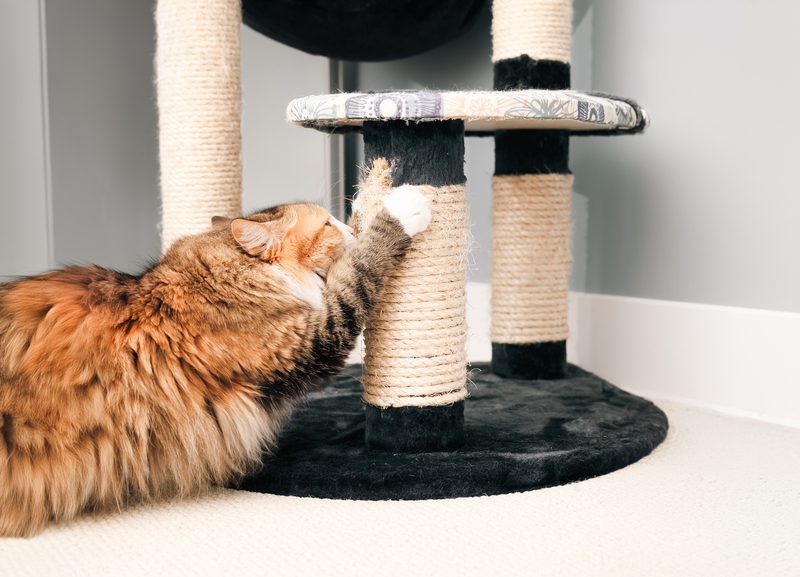How to Keep Indoor Cats Happy
As loving cat owners, we naturally want our furry companions to lead happy and fulfilling lives. For those of us who keep our cats indoors, ensuring their happiness can sometimes feel like a daunting task. The debate around indoor cats often centres on whether it’s cruel to keep them confined to our homes, but the truth is that indoor life can be immensely rewarding when we provide them with the right environment and care.
In this article, we’ll explore why keeping your cat indoors can be a great choice, and we’ll delve into ten essential tips that will help you create a vibrant and stimulating life for your indoor feline friend. From enriching their environment to understanding their healthcare needs, we’ll cover everything you need to know about making your indoor cat a happy cat.
Why Keep Your Cat in the House?
The question of whether cats need to go outside can spark heated debates among pet owners. On one hand, some argue that outdoor access is essential for a cat’s well-being; on the other hand, many experts suggest that indoor living can be just as fulfilling when done correctly.
Let us explore the debate of “Do Cats Need to Go Outside?”. Outdoor cats have the freedom to explore, climb trees, and engage in natural hunting behaviours. However, this freedom comes with significant risks. Traffic accidents, encounters with aggressive animals, exposure to diseases, and other dangers can pose serious threats to a cat’s health. Moreover, outdoor cats can also impact local wildlife, making the decision to keep them indoors beneficial for both the cat and the ecosystem.
Keeping your cat indoors has grown in popularity, and for good reason. While many people think of cats as independent animals that benefit from the freedom to roam, keeping them as indoor pets comes with numerous advantages. Here are some compelling reasons why an indoor lifestyle might be the best choice for your pet cat:
Safety is one of the most crucial reasons to consider an indoor lifestyle for your cat. Outdoor environments can pose significant risks to cats, who may encounter hazards like busy streets, hostile wildlife, toxic plants, and other dangers.
Moreover, outdoor cats have an increased risk of contracting diseases such as feline leukaemia virus (FeLV) or feline immunodeficiency virus (FIV), both of which can severely impact a cat’s health. FeLV and FIV are transmitted through contact with infected cats, such as during fights. In addition, there are parasites like fleas, ticks, and worms that can affect both indoor and outdoor cats but are far more common outdoors. Hence, keep up to date with the vaccination for your cat.
By keeping your cat indoors, you can significantly reduce these risks, helping them to live a longer and healthier life. Although some may wonder, “Is it cruel to keep a cat indoors?” the reality is that a well-cared-for indoor cat can thrive, provided they have the right environment and stimulation.
Indoor cats typically live much longer than those who are allowed outside, as they’re not exposed to the same risks. Studies suggest that while an outdoor cat may live anywhere between 2-5 years, indoor cats can live up to 10-20 years or more.
10 Tips to Keep Your Cat Happy and Healthy Indoors
Maintaining a comfortable and stimulating indoor environment for your cat is key to keeping your cat healthy both mentally and physically. An enriched, interactive home life can be deeply fulfilling for indoor cats, offering safety, mental stimulation, and comfort. Here are ten expert tips to ensure your indoor cats stay entertained, happy, and healthy, proving that an indoor lifestyle can be just as enriching as the outdoors.
1. Enrich Their Environment
Cats are natural climbers, and creating an environment that encourages this behaviour can help indoor cats feel more engaged. A well-placed cat tree or a series of cat-friendly shelves can satisfy their love for vertical spaces. Position these in high-traffic areas so they can observe and interact with their surroundings. High perches allow cats to survey their “territory,” giving them a sense of security, which can significantly reduce anxiety.
In addition to vertical spaces, hiding spots are equally crucial for cats, providing them with cosy, secluded areas to retreat to when they need rest. Cardboard boxes, tents, or even repurposed furniture can serve as perfect hiding spots, giving your cat a private place to rest. These small additions can make a significant difference in how comfortable and engaged your indoor cat feels in their home.
Furthermore, scratching posts are also essential for marking territory and keeping claws healthy. Encourage this natural behaviour by placing scratching posts near their favourite spots and other key areas in your home. Not only will your cat appreciate it, but it also protects your furniture from unwanted claw marks.
2. Provide a Variety of Indoor Cat Toys
Cats have a strong hunting instinct, and indoor cat toys that simulate prey-like movements can keep them mentally and physically stimulated. Toys such as feather wands, laser pointers, and crinkle balls encourage natural pouncing, stalking, and chasing behaviours, providing the exercise they need to stay healthy. Interactive toys like these are great for cats of all ages and are especially useful for high-energy breeds or younger cats who require more playtime.
Catnip toys can also be incredibly effective, offering a sensory experience that keeps many cats entertained for hours. A variety of toys keeps things exciting for them and prevents them from becoming bored.
3. Rotate Toys to Keep Things Fresh
Keeping your indoor cat entertained over time requires a little creativity. Cats can grow tired of their toys if they’re constantly exposed to the same ones. Rotating toys every couple of weeks keeps their interest alive and reignites their play instincts. Simply put some toys away for a few days and reintroduce them later, creating the effect of a “new” toy each time. Sometimes, cats can be smart, but sometimes, this trick just works out well.
It’s also beneficial to observe which toys your cat favours. While some may love a feather on a string, others may prefer batting balls around or pouncing on crinkle mats. Customising play sessions to their preferences can bring out their unique personalities and further enrich their playtime experience.
4. Create a Cat-Friendly Play Area
Creating an indoor cat play area is an effective way to offer your cat a dedicated space to exercise and explore. This area doesn’t have to be a large one—it could simply be a corner with a cat tree, a scratching post, and a few toys. Tunnels, climbing structures, and soft mats for lounging can complete the space, making it a place where your cat can satisfy their natural behaviours in a safe, controlled environment.
If you have more than one cat, having multiple climbing structures and toys can help prevent territorial disputes, giving each cat their space. For homes with limited space, you can still create vertical play areas using wall-mounted shelves or stackable climbing blocks. This can turn any small area into a fun and stimulating environment, ensuring your cat has everything they need to stay active.
5. Establish a Regular Flea and Tick Treatment Routine
It’s a common misconception that indoor cats don’t need flea or tick prevention. While indoor pets have a lower risk, it’s still possible for fleas and ticks to enter your home via people, other animals, or even through open windows. Therefore, regular treatment for your cat remains crucial, even if they’re solely indoors. Many options are available, from spot-on treatments to flea collars and oral medications. Consult your vet to choose the best option for your cat.
6. Make Mealtime Interactive
Turning mealtime into a fun, engaging activity is a great way to keep your cat mentally stimulated. Puzzle feeders or treat-dispensing toys require your cat to work for their food, tapping into their natural hunting instincts. Interactive feeders can be especially helpful for cats prone to overeating, as they naturally control portion sizes and prevent the “boredom eating” that some indoor cats may adopt.
7. Train Your Cat with New Tricks
Contrary to popular belief, cats are highly trainable and can learn a variety of tricks. Training your cat with simple commands like “sit,” “high five,” or “come” not only stimulates their minds but also strengthens the bond between you. Positive reinforcement training with treats or affection encourages them to learn, and it can be an enjoyable bonding experience.
8. Keep the Litter Box Clean
A clean litter box is fundamental to good indoor cat care. Cats are meticulous animals and appreciate a clean, odour-free area for their business. Scoop their litter box daily and fully change the litter weekly to keep it fresh. Additionally, you may want to experiment with different types of litter to find one your cat prefers.
Placing the litter box in a quiet, easily accessible spot ensures your cat feels comfortable using it. Avoid placing the litter box near loud appliances or in busy parts of the home, as these can deter cats from using it.
9. Engage in Daily Playtime Sessions
Setting aside time each day for play helps burn off energy and allows your cat to practice their hunting instincts. Use feather wands, laser pointers, and balls for games that involve stalking, pouncing, and chasing, all of which help keep them mentally and physically fit.
Ideally, schedule at least two play sessions per day, each lasting around 15 minutes, to give your cat a good amount of exercise and stimulation. Regular play not only helps manage their weight and keeps them agile but also reduces the likelihood of behavioural issues that can arise from boredom or excess energy.
10. Spend Quality Time and Offer Affection
Though cats are often seen as independent creatures, they still require attention, affection, and companionship to feel secure and happy. Spending quality time with your cat through petting, grooming, or simply sitting beside them reinforces the bond you share. Many indoor cats are deeply affectionate and enjoy the closeness, showing signs of contentment by purring, kneading, or curling up beside you. A happy cat will express their joy with playful behaviour, purring, and rubbing against you, which is rewarding for both of you.
Book Cat Boarding at Hunters Lodge Today
As much as we strive to keep our indoor cats happy, there are times when we must leave them for work or travel. In these instances, consider boarding your cat at Hunters Lodge, where your pet will receive exceptional care in a safe and comfortable environment.
At Hunters Lodge, our cattery is designed to provide a fun and exciting atmosphere for your cat, complete with spacious accommodations, plenty of toys, and a caring staff dedicated to ensuring their well-being. Your feline friend will enjoy their time away from home while you can relax, knowing they are in good hands.
Explore our gallery to get a glimpse of Hunters Lodge’s cosy, welcoming cattery and see why it’s the perfect place for your feline friend to stay. Your pet will enjoy their time away from home while you can relax, knowing they are in good hands.
To learn more about our services or to make a reservation, call us today at 01604 870330 or contact us through our website. We look forward to providing your beloved cat with the care they deserve while you’re away!

